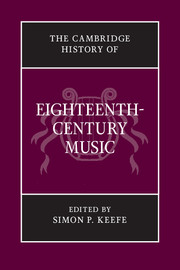Book contents
- Frontmatter
- PRELUDE
- PART I MUSIC FOR THE CHURCH
- 2 Catholic church music in Italy, and the Spanish and Portuguese Empires
- 3 Catholic sacred music in Austria
- 4 Catholic church music in France
- 5 Lutheran church music
- 6 Protestant church music in England and America
- INTERLUDE
- PART II MUSIC FOR THE THEATRE
- INTERLUDE
- PART III MUSIC FOR THE SALON AND CONCERT ROOM
- POSTLUDE
- Appendix I Chronology
- Appendix II Institutions in major European cities
- Appendix III Personalia
- Index
- References
5 - Lutheran church music
from PART I - MUSIC FOR THE CHURCH
Published online by Cambridge University Press: 28 March 2011
- Frontmatter
- PRELUDE
- PART I MUSIC FOR THE CHURCH
- 2 Catholic church music in Italy, and the Spanish and Portuguese Empires
- 3 Catholic sacred music in Austria
- 4 Catholic church music in France
- 5 Lutheran church music
- 6 Protestant church music in England and America
- INTERLUDE
- PART II MUSIC FOR THE THEATRE
- INTERLUDE
- PART III MUSIC FOR THE SALON AND CONCERT ROOM
- POSTLUDE
- Appendix I Chronology
- Appendix II Institutions in major European cities
- Appendix III Personalia
- Index
- References
Summary
The history of Lutheran church music in the eighteenth century is often described as a culmination and then a decline. Johann Sebastian Bach is regarded as the pinnacle of Lutheran music; then, according to Georg Feder, ‘there is unanimity of opinion that Protestant church music after Bach declined in comparison to the achievements of earlier days’. Certainly church music underwent a crisis in the second half of the eighteenth century. Changed religious ideals, inspired by the Enlightenment, increasingly sought simple and intelligible music, eschewing worldly or learned elements. Furthermore, with the rising secularization of society, the church became less important in musical life; composers and performers instead focused on public concerts, music-publishing and other secular enterprises. The very institutions of Lutheran church music were also undermined, with the dissolution of most of the school choirs that had formerly sung in churches.
Yet it is hard to assess these major changes in Lutheran church music, mainly because most researchers and performers concentrate on J. S. Bach to the exclusion of his contemporaries and successors. Until there are more recordings and modern editions of the church music of composers such as Johann Friedrich Doles, Gottfried August Homilius, Johann Philipp Krieger, Gottfried Heinrich Stölzel and Georg Philipp Telemann, it is inevitable that Bach’s output will look like an isolated summit. Gradually the situation is changing, with selected works of Homilius, Stölzel and Telemann undergoing a revival via new editions and recordings.
- Type
- Chapter
- Information
- The Cambridge History of Eighteenth-Century Music , pp. 127 - 167Publisher: Cambridge University PressPrint publication year: 2009

